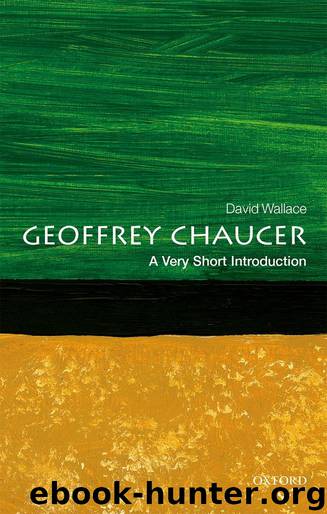Geoffrey Chaucer by David Wallace

Author:David Wallace [Wallace, David]
Language: eng
Format: epub
ISBN: 9780191080388
Publisher: OUP Oxford
Published: 2019-06-24T00:00:00+00:00
Genre: no genre
Sixteenth-century editors of Chaucer needed to represent him as at once strange and familiar, foreign and one of us. He is one of us as an Englishman, and as founding father of a great poetic tradition. He is strange because Roman Catholic, on the far and wrong side of the Reformation. Emphasizing the strangeness of Chaucer’s language helped to articulate this divide, and kept print editors gainfully employed in supplying glosses, commentaries, and textual apparatuses for their readership. We live with this legacy today: Chaucer is read aloud, when read at all, as medieval, in need of explaining, whereas Shakespeare performs as if contemporary, de nos jours. This arbitrary divide narrows if we follow Shakespeareans in aiming, above all, to put over the meaning of a passage; Chaucer can be performed by and through whole bodies, rather than declaimed from the page. One aspect of Chaucer did, however, genuinely baffle the 16th century: his wild variety of generic forms; his bewildering array of discursive performances within each form. Since Chaucer seems to have produced no single, stabilized, standardized literary form, the Boccaccian novella seemed a much better bet for adoption and imitation. Renaissance homogenization thus won out over medieval diversity.
Chaucer does provide some suggestions concerning form as guide to content, most notably with rhyme royal. Within CT, such stanzas as employed by the Man of Law, Clerk, Prioress, and Second Nun support serious, religiously inflected content. But Chaucer’s longer-line, five-stress couplets, CT’s great metrical warhorse, support all kinds of narrative; Fragment I moves seamlessly downhill from Knight to Cook without a change of metre. Tail rhyme, a staple of popular Middle English romancing, features in the pilgrim Chaucer’s Sir Thopas but is then chased from the stage by Chaucer’s Host (7.919–31). The Host also abets the Knight in terminating the Monk’s ababccbc stanzas (similar to, but not identical with, Boccaccian ottave), finding in them ‘ne disport ne game’ (neither pastime nor fun, 7.2791). The Monk’s sin against conviviality lies not in narrating ‘tragedie’, his announced genre (7.1991), but one bloody tragedy after another, a catalogue of great men’s falls. The tale’s manuscript subtitle, De casibus virorum illustrium, exactly reproduces the title of a Latin work by Boccaccio, a neo-humanist compiling of the fates of great men. It was under Petrarch’s influence that Boccaccio turned away from vernacular (mother tongue) composition in the 1350s to concentrate on Latin encyclopaedism; another of his works, De mulieribus claris, supplied material for Chaucer’s Legend of Good Women. In the Monk’s Tale, Chaucer provides us both with a first English sampling of this proto-humanist genre and a first popular English reaction to it: boring!
Chaucer’s Host also itches to interrupt the Squire, since the young man (the only person on pilgrimage known to be young) is floundering, unable to manage the elaborate figures of speech that his father, the Knight, has handled peerlessly. This time, it is the Franklin who drops the boom, with the Host following in close behind. His strategy, brilliantly simple,
Download
This site does not store any files on its server. We only index and link to content provided by other sites. Please contact the content providers to delete copyright contents if any and email us, we'll remove relevant links or contents immediately.
| Ancient & Classical | Arthurian Romance |
| Beat Generation | Feminist |
| Gothic & Romantic | LGBT |
| Medieval | Modern |
| Modernism | Postmodernism |
| Renaissance | Shakespeare |
| Surrealism | Victorian |
4 3 2 1: A Novel by Paul Auster(11113)
The handmaid's tale by Margaret Atwood(6912)
Giovanni's Room by James Baldwin(5961)
Big Magic: Creative Living Beyond Fear by Elizabeth Gilbert(4779)
Asking the Right Questions: A Guide to Critical Thinking by M. Neil Browne & Stuart M. Keeley(4639)
On Writing A Memoir of the Craft by Stephen King(4261)
Ego Is the Enemy by Ryan Holiday(4042)
Ken Follett - World without end by Ken Follett(4000)
The Body: A Guide for Occupants by Bill Bryson(3882)
Bluets by Maggie Nelson(3757)
Adulting by Kelly Williams Brown(3716)
Guilty Pleasures by Laurell K Hamilton(3629)
Eat That Frog! by Brian Tracy(3562)
White Noise - A Novel by Don DeLillo(3464)
The Poetry of Pablo Neruda by Pablo Neruda(3403)
Alive: The Story of the Andes Survivors by Piers Paul Read(3346)
The Book of Joy by Dalai Lama(3274)
The Bookshop by Penelope Fitzgerald(3260)
Fingerprints of the Gods by Graham Hancock(3253)
